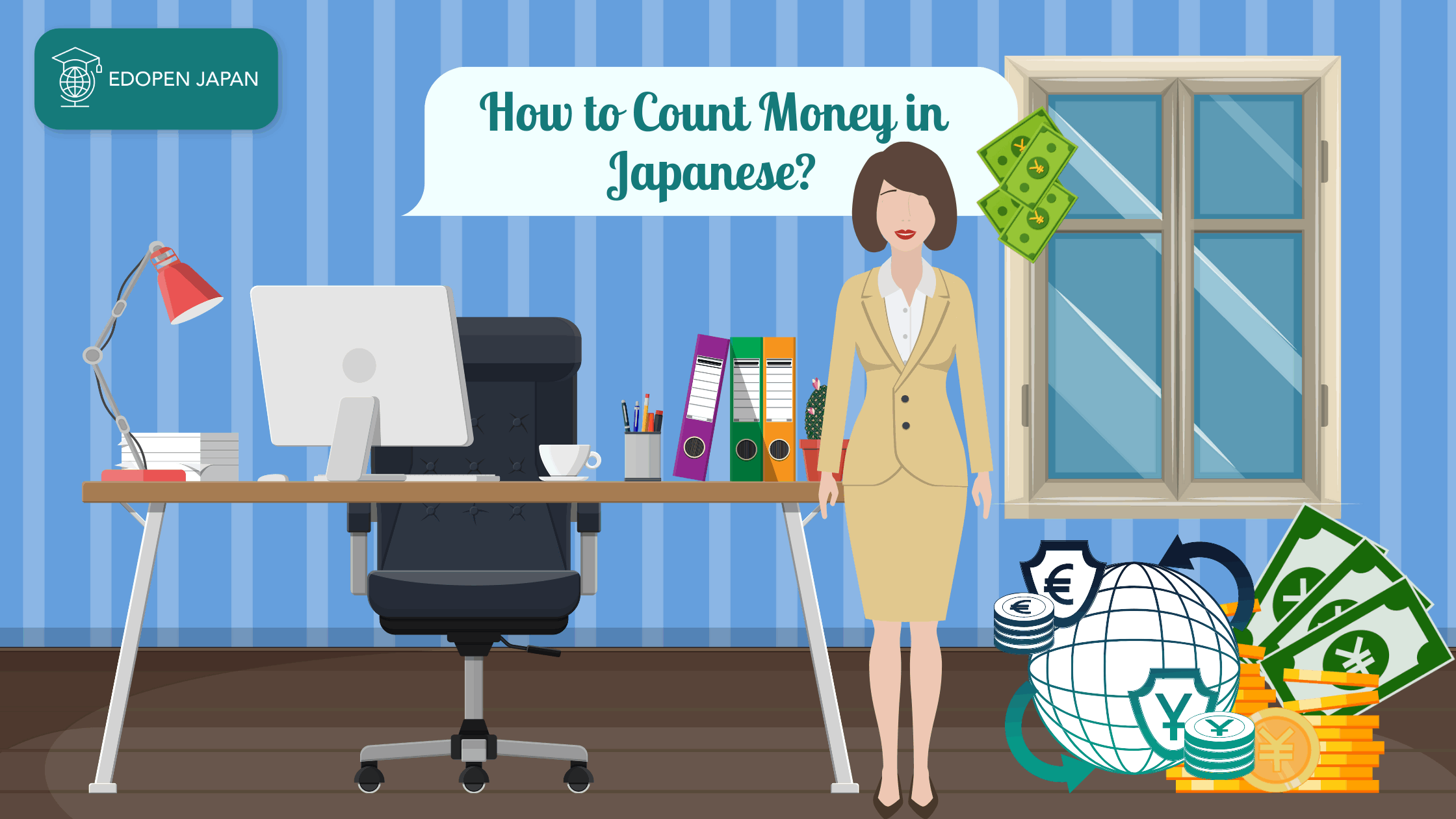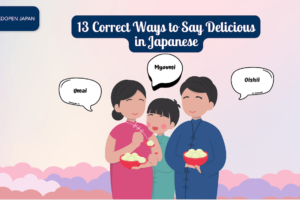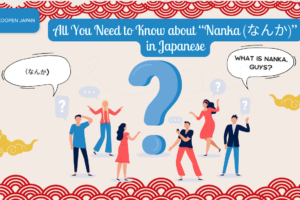When you come to Japan, you need to have enough knowledge about money in Japanese. Being skillful enough on how to count money in Japanese would avoid mistakes as well as confusion. This article will be a good start for you.
Surely, by reading this article, you can get everything you need to know about Japanese money. Whenever you travel in Japan, you will need this information.
What’s more? Here in our media, we have collected a lot of useful information for you to learn the Japanese language and culture. After you finish reading this article, please also take a look at the other informative articles here as well. Please leave your comments in the section below for our improvement. Thank you very much! Happy reading! We hope you find this article useful!
In addition, if you’re looking to learn other famous Japanese phrases that are often used in everyday Japanese conversation, check out our discussion below:
Read also:
15 Great Ways to Say Thank You in Japanese
11 Great Ways to Express Sorry in Japanese
How to express I love you in Japanese?
Contents
The Japanese Currency (円・えん or Yen)

First of all, please remember that the official currency of Japan is the Yen. The term yen comes from the Japanese character (kanji) 円 (えん, en), which literally means round. Please see below for more information about the Japanese currency.
- Japanese currency: Yen
- In Japanese: 円 (en)
- Symbol of Japanese currency: ¥
- The International code: JPY or JP¥
For your information, the Japanese currency is the third most traded currency in the Forex market. Where the 1st and 2nd places are the United States Dollar (US$) and the Euro (€).
In addition, Japan’s former currency before the yen was the mon. Due to the instability of Japan’s financial condition at that time, the Japanese government decided to replace the Mon currency with the Yen as we know it today.
The Mon currency, which had been used since the Edo period, was considered less stable as a medium of exchange because it did not have a clear standard of exchange.
Money in Japanese
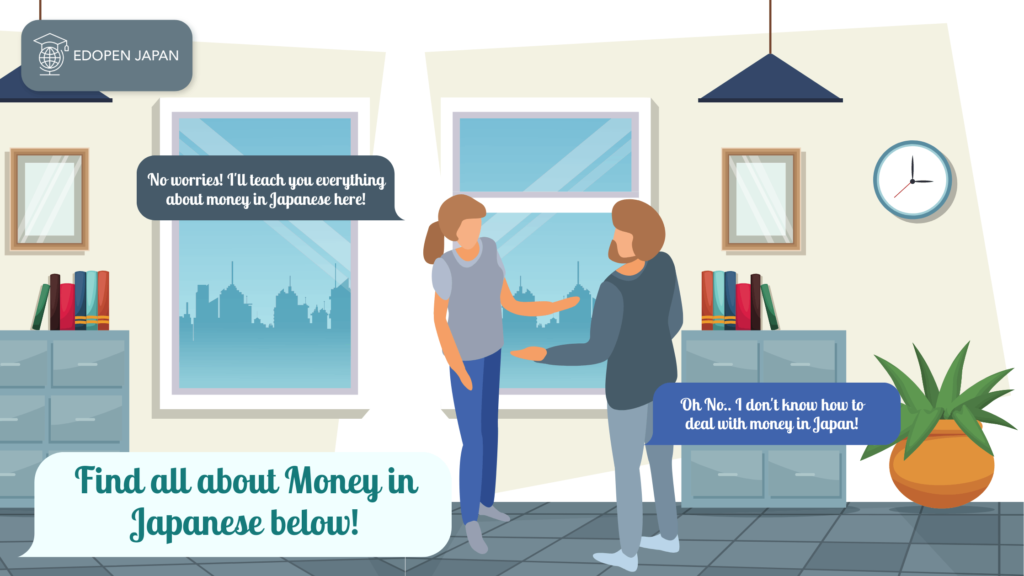
Now that you know the Japanese currency, in this section you will learn what money is in Japanese. Do you know how to say “money” in Japanese? I will explain it to you. Japanese people would certainly say money as “Okane” or “Kane” in everyday conversation. The kanji for money in Japanese is as follows:
- 御金 or お金 (おかね): Okane, a noun with the honorific prefix O (Formal)
- 金 (かね): Kane, a noun without the honorific prefix. (Casual)
The Kanji 金 (Kane) has another way to be pronounced as kin or king, which means gold or metal in general.
The Banknotes and Coins in Japan

In Japan today, there are 1,000 yen, 2,000 yen, 5,000 yen, and 10,000 yen banknotes in circulation. Not only the banknotes, but you would also find the coins in 1 Yen, 5 Yen, 10 Yen, 50 Yen, 100 Yen, and 500 Yen denominations. This is slightly different from other countries around the world that use the president or leader of their country as the currency symbol.
In contrast, in Japan, the Japanese use Nobel laureates, novelists, and educational figures as currency icons to respect and recognize their legacy. How do you say the number of these amounts in Japanese? Please refer to the following table.
| Amounts of Money | Japanese | English |
| Banknotes: (1) 1,000¥ | 千円 (せんえん): (is-) sen en | One thousand yen ~ $10 USD |
| (2) 2,000¥ | 二千円 (にせんえん): ni sen en | Two thousand yen ~ $20 USD |
| (3) 5,000¥ | 五千円 (ごせんえん): go sen en | Five thousand yen ~ $50 USD |
| (4) 10,000¥ | 一万円 (いちまんえん): Ichi man en | Ten thousand yen ~ $100 USD |
| Coins (5) One-yen | 一円 (いちえん): Ichi en | One cent ~ $0,008 USD |
| (6) Five-yen | 五円 (ごえん): Go en | Five cent ~ $0,043 USD |
| (7) 10-yen | 十円 (じゅうえん): Jyu en | Ten cent ~ $0,087 USD |
| (8) 50-yen | 五十円 (ごじゅうえん): Go jyu en | 50 cent ~ $0,43 USD |
| (9) 100-yen | 百円 (ひゃくえん): Hyaku en | Hundred yen ~ $0,87 USD |
| (10) 500-yen | 五百円 (ごひゃくえん): Go hyaku en | Five hundred yen ~ $4,33 USD |
Each note has a specific and very beautiful design. The size of Japanese banknotes is slightly larger than US banknotes. The Japanese are very careful to keep their money fresh, clean and not wrinkled in their pockets. Please take a look at the pictures below to get an impression of Japanese banknotes and coins.
How to Count Money in Japanese
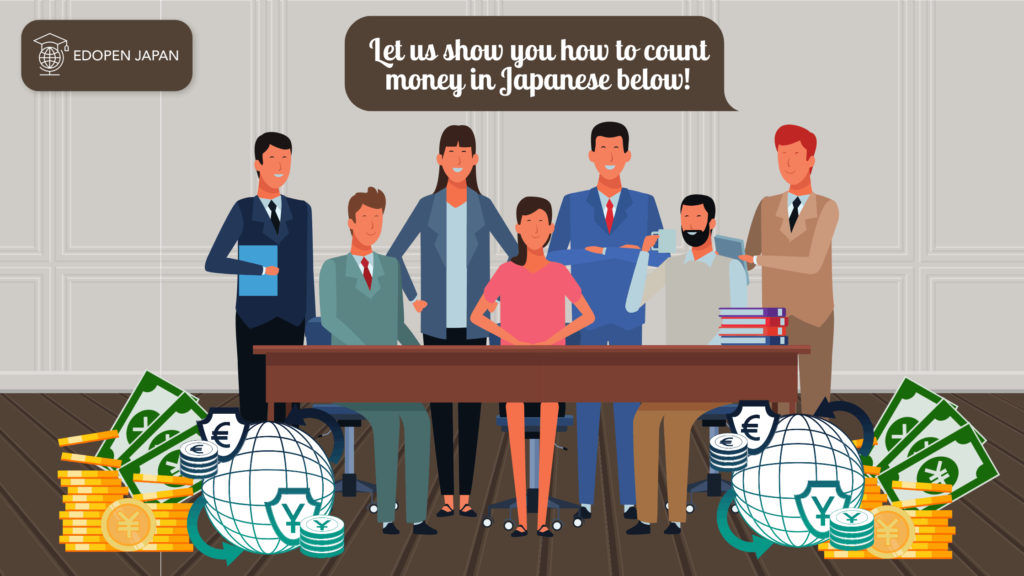
To deepen your understanding of how to count money in Japanese, please see the numbering in Japanese for your base. Since you can remember the number in Japanese, this will not be difficult.
(1) One and Two-digit Numbers
To begin this basic learning, we will begin by counting one, two, and three digit numbers. Please refer to the following table:
| List of Number | Japanese |
| 0 (Zero) | ゼロ: Zero or Rei |
| 1 (One) | 一 (いち) : Ichi |
| 2 (Two) | 二 (に): Ni |
| 3 (Three) | 三 (さん): San |
| 4 (Four) | 四 (し or よん) : Shi or Yon |
| 5 (Five) | 五 (ご): Go |
| 6 (Six) | 六 (ろく): Roku |
| 7 (Sichi) | 七 (しち or なな): Shichi or Nana |
| 8 (Eight) | 八 (はち): Hachi |
| 9 (Nine) | 九 (きゅう): Kyuu or Kuu |
| 10 (Ten) | 十 (じゅう): Jyuu or Juu |
The following is the 2-digit number. Basically, we just need to add Jyuu or Juu, which means ten in Japanese, after the first digit number. See below!
| List of Number | Japanese |
| 20 (Twenty) | 二十 (にじゅう): Ni Jyuu or Ni Juu |
| 30 (Thirty) | 三十 (さんじゅう): San Jyuu |
| 40 (Forty) | 四十 (よんじゅう): Yon Jyuu |
| 50 (Fifty) | 五十 (ごじゅう): Go Jyuu |
| 60 (Sixty) | 六十 (ろくじゅう): Roku Jyuu |
| 70 (Seventy) | 七十 (ななじゅう): Nana Jyuu |
| 80 (Eighty) | 八十 (はちじゅう): Hachi Jyuu |
| 90 (Ninety) | 九十 (きゅうじゅう): Kyuu Jyuu |
| 100 (Hundred) | 百 (ひゃく): Hyaku |
(2) Three-digit Number
Next, we can use a similar concept as above for the three-digit number. Since a hundred in Japanese is 百 (ひゃく) Hyaku, we can add Hyaku after the first digit number. Please refer to the following table:
| List of Number | Japanese |
| 200 (Two hundred) | 二百 (にひゃく): Ni hyaku |
| 300 (Three hundred) | 三百 (さんびゃく): San byaku *exception |
| 400 (Four hundred) | 四百 (よんひゃく): Yon hyaku |
| 500 (Five hundred) | 五百 (ごひゃく): Go hyaku |
| 600 (Six hundred) | 六百 (ろっぴゃく): Roppyaku *exception |
| 700 (Seven hundred) | 七百 (ななひゃく): Nana hyaku |
| 800 (Eight hundred) | 八百 (はっぴゃく): Happyaku *exception |
| 900 (Nine hundred) | 九百 (きゅうひゃく): Kyuu hyaku |
| 1000 (One Thousand) | 一千円 or 千円 (いっせんえん or せんえん): Issen en or Sen en |
In this part, let’s try the real example. Let’s say you go to the store to buy groceries and your total bill is 1,876¥. How do you say this in Japanese?
The answer is: 1,876¥ becoming 一千八百七十六円 (いっせん はっぴゃく ななじゅう ろく えん)
Issen happyaku nana jyuu roku en!
That’s not difficult, is it?
(3) Four-digit Numbers
In the case of a four-digit number, we basically just need to add sen after the base number. Please refer to the following table:
| List of Numbers | Japanese |
| 2,000 (Two thousand) | 二千円 (にせんえん): Ni sen en |
| 3,000 (Three thousand) | 三千円 (さんぜんえん): San zen en *exception |
| 4,000 (Four thousand) | 四千 (よんせん): Yon sen |
| 5,000 (Five thousand) | 五千 (ごせん): Go sen |
| 6,000 (Six thousand) | 六千 (ろくせん): Roku sen |
| 7,000 (Seven thousand) | 七千 (ななせん): Nana sen |
| 8,000 (Eight thousand) | 八千 (はっせん): Has sen *exception |
| 9,000 (Nine thousand) | 九千 (きゅうせん): Kyuu sen |
| 10,000 (Ten thousand) | 一万 (いちまん): Ichi man |
Now let’s try the real example again. Let’s say you have to pay your electric bill of 12,867¥ for last winter. Do you know how to pronounce this amount in Japanese?
The answer is 12,867¥ ~ 一万二千八百六十七円 (いちまん にせん はっぴゃく ろくじゅう なな えん).
It is Ichi man happyaku roku jyuu nana en. Isn’t it simple?
Actually, there are more digits that we need to talk about regarding money in Japanese. Unfortunately, for this article, these basics would be more than enough for the first step for you to learn.
Let’s meet again in the next article for a more comprehensive and advanced discussion on how to count money in Japanese with five or more digits.
About Cash in Japanese (現金 or Genkin)

As you may have noticed, although Japan has a very good reputation as an advanced country, most Japanese still prefer to pay in cash. There is no denying that cash is still very popular, especially for everyday transactions.
In this section, I would like to show you how to express “cash” in Japanese. It is 現金 (げんきん): Genkin. Please remember this kanji because wherever you go, you will be dealing with this payment method a lot. Having Genkin as well as the word 現金 will surely help you the most. Do not forget this very important word wherever you are in Japan.
As long as you have cash, you will be fine. You can get cash at most ATMs in Japan. You can get it in a tourist-friendly area, of course with English instructions available at the ATM. Unfortunately, you need to have coins ready when you get on the bus. If you want to use IC Card as another payment option, that would be easier as well. You can get IC Card at the bus station.
Conclusion
Last but not least, we can sum up this article in the following points:
- The official currency of Japan is the ¥ (yen).
- Japanese call money “お金” or “Okane“.
- In Japan, there are banknotes (paper money) and coins circulating with the respective denominations.
- Cash is called “現金 or genkin” in Japanese.
We would like to thank you for spending your precious time reading this article. If you have some free time, we also would like to recommend you to read our Rich Lesson article that you can find here. There you can learn Japanese with very simple concepts. Within 10 minutes, you can obviously master practical Japanese.

